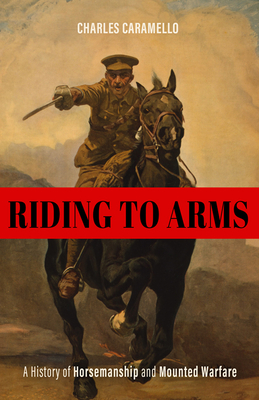Riding to Arms
- By Charles Caramello
- University Press of Kentucky
- 310 pp.
- Reviewed by Mark G. Spencer
- March 12, 2023
An homage to the mighty steed and the works inspired by it.

In Riding to Arms, Charles Caramello provides, as he puts it in his subtitle, “A History of Horsemanship and Mounted Warfare.” Those seeking a historical-survey volume of that topic may not find what they expect, however. Caramello — who is emeritus professor of English at the University of Maryland and John H. Daniels Fellow at the National Sporting Library and Museum in Middleburg, Virginia — approaches his field through five distinct chapters which, as he writes in his preface, “can stand individually.” These episodic studies are arranged chronologically and fit together reasonably well, in this book published in the University Press of Kentucky’s “Horses in History” series.
In chapter one, “Ryding and Breakinge,” Caramello argues that “classical horsemanship was revived in Italy in the sixteenth century and, through a succession of weighty and influential riding masters, migrated to France in the seventeenth and eighteenth centuries.” The examination encompasses writers on these topics ranging from Xenophon of Athens (d. 354 BC), a Greek military leader, historian, and philosopher; to Dom Duarte (1391-1438), the king of Portugal; and, centrally, Federico Grisone (1507-70), whose influential Gli ordini di cavalcare (The Rules of Riding) was translated into English in 1560 as The Art of Ryding and Breakinge Greate Horses.
Later, in the 17th and 18th centuries, historiographical works of seminal importance included William Cavendish’s A General System of Horsemanship (1658), François Robichon de la Guérinière’s École de Cavalerie (1733), and Richard Berenger’s The History and Art of Horsemanship (1771). Several of these “giants” figure in the book’s later discussions as well.
Chapters two, “Manège to Field,” and three, “Light-Horse, Dragoons, and Others,” give considerable attention to developments in cavalry through to the end of the First World War. Among the themes developed is that field sports and cavalry often evolved together in a reciprocal relationship.
Chapter four, “Remounts and Wastage,” demonstrates that, while WWI “was fundamentally an infantry and artillery war, not a cavalry war,” horses still very much mattered. The Great War “was largely a horse war,” Caramello reminds us in detail, often depressing. “Military horses were bought, bred, shipped, trained, deployed, wounded and nursed, and killed, buried, or cast, in numbers that beggar the imagination.”
Here, and elsewhere, the former professor of English literature references not only historical sources but also works of fiction. He fleshes out, for example, the place of horses in Ernest Hemingway’s novels. Other types of source materials are also tapped. Chapter five, “Hunting in the Trenches,” concludes with a discussion of Jean Renoir’s La Grande Illusion (1937), “a film about the cavalry of the clouds in the Great War.” Here, Caramello writes:
“The future demise of horse cavalry signaled by the Great War, together with the mass mechanized slaughter of the war, issued in postwar nostalgia not only for the prewar image of ‘smart’ cavalry, but also for a prewar vision of a vibrant and idyllic country life exemplified by the foxhunt and eulogized by writers like Siegfried Sassoon.”
Taken together, the chapters offer a wide-ranging, at times meandering conversation that casts much light on the place of horses in warfare from the 16th century through to the 20th. It is worth highlighting, too, Caramello’s claim that his contribution is primarily “a book about books.” Riding to Arms, he submits, “constitutes, in effect, a study in the history of ideas about horsemanship and cavalry more than a study in equine or military history per se.”
This leads to some gaps in the military events covered. There is almost nothing on horses in the Revolutionary War, for instance, and works like Jim Piecuch’s edited collection, Cavalry of the American Revolution, go unnoticed here. Caramello’s targeted readership, he tells us, is “academic scholars and students of equine or military history.” They will not be disappointed by his closely argued text or its almost 100 pages of information-packed endnotes and bibliography of primary and secondary sources.
Still, his enthusiasm for all things related to horses and horsemanship very much shines through in these pages. One suspects that not all readers will be keen to come along for the ride, but some will. For “general horse enthusiasts and cavalry buffs,” there is much here that is entertaining and instructive.
Among the volume’s 10 black-and-white illustrations is the central image from Lucy Kemp-Welsh’s (1869-1958) “iconic calvary recruitment poster” of 1915, “Forward! Forward to Victory Enlist Now.” The British painter’s striking image depicts a dark horse with hauntingly wild eyes at full gallop, carrying his mounted soldier, sword drawn, charging into battle. Appropriately, it also graces the cover of Riding to Arms.
[Editor's note: This review originally ran in 2022.]
Mark G. Spencer is professor of history at Brock University. Along with the Independent, he reviews for the Times Literary Supplement, the Wall Street Journal, and the Washington Post, among other publications.

